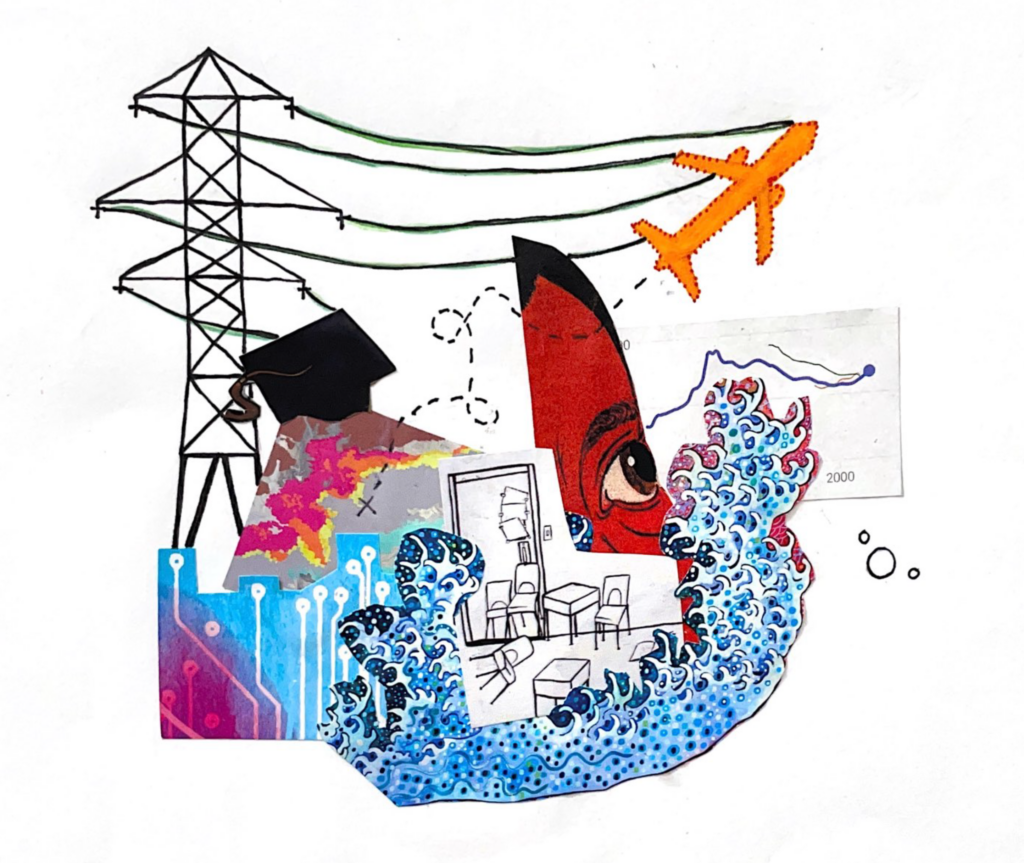A Futurist’s Vision for Higher Education in a Climate-Altered World
By Marion Cassidy, CAS ‘23

Collage of a wave, face, chairs, circuits with a drawn power line and airplane to represent the images in Bryan Alexander’s book as discussed in the article. Design by Cecilia Cassidy
As a futurist, Bryan Alexander has spent years considering the possibilities of what lies ahead.
An adjunct lecturer at Georgetown, Alexander’s life’s work is to create a new and better future across various industries, including higher education. In his new book Universities on Fire: Higher Education in the Age of Climate Crisis, published in March 2023, Alexander investigates how the physical and figurative effects of climate change will impact universities and colleges in the coming years.
From Hollywood to the Vatican, the world has begun to grapple with the impact of climate change on every facet of life. Few, however, have examined the connection between universities and climate change. In his new book, Alexander begs the question, “If climate change is our next big fight, what can universities do to make a difference?”
When Alexander considered the relationship between climate change and universities, his first thought was the physical threat of climate change on university campuses. With sinking coastlines and increases in natural disasters like hurricanes and floods, Alexander considered the possibility that many American universities may have to move to new locations to adapt to changing conditions. Miami, home to several prominent universities like the University of Miami and Florida International University, is already facing urgent flooding and environmental threats. The city’s coastal location and low-lying geography make it especially vulnerable to rising sea levels and powerful hurricanes. Alexander wonders if and when universities may decide to relocate to areas less at risk of climatic disaster.
“You wonder about how many universities’ locations are in physical danger, and there are many other natural dangers,” notes Alexander, “A couple of the colleges I talked to on the West Coast deal with fire threats every year and have had to create more specific processes to mitigate those dangers.”
Alexander goes on to explore the significant opportunities for universities to reduce their environmental impact through better campus management. “Are their buildings carbon neutral or carbon negative? Do they use electrical power?,” asks Alexander who goes on to cite Berea College in Kentucky as an example. In a recent effort to reduce their environmental impact, the university made the switch from fossil fuels to hydroelectric power, generated from a plant they built on campus.
When it comes to reducing their carbon footprint, universities can take a variety of actions, both large and small. For example, universities may switch to using only electric vehicles on campus or plant-based foods in the dining hall.
But perhaps the most controversial issue of all is the use of air travel: “We have faculty and staff fly for research, for professional development, for programs of all kinds,” explains Alexander, “We have student-athletes who often fly to events. Students leave town and fly to other countries for spring break, and there is also study abroad, which again is based on air travel. We don’t have alternatives to CO2 emitting aircrafts right now, so should universities scale travel back?”
Given the immediate – and future – threat of climate change, why haven’t more universities taken action? In Alexander’s opinion, many universities are hesitant to take bold action on climate change because they fear the political backlash. He shares the example of one university president who said that half of the students and trustees came from fracking communities in North Dakota, where fracking is seen as a positive economic force. But the other half of the community was made up of green activities who opposed fracking. The President told Alexander that she felt she couldn’t balance both sides, so she chose to remain silent.
Given the immediate – and future – threat of climate change, why haven’t more universities taken action?
Beyond physically protecting themselves, universities have much to gain from making environmental strides. A study by the Pew Research Center found 67% of Gen Z participants felt that climate should be a top priority to ensure a sustainable planet for future generations. Alexander notes, “If you want to connect with students, this is a huge issue to connect on. If schools are worried about student mental health, which I think everybody in higher education is, then giving students something to do with climate change can be really positive.”
Many universities have begun to address the climate crisis on their campuses, but could they do more by working together? “I would love to see more collaboration between universities as well,” says Alexander, “Imagine one hundred college campuses get together, form an alliance, and they support a kind of student climate Peace Corp where students can take a year off and go someplace and work on climate issues.”
While not all of Alexander’s ideas have been implemented in universities, they nonetheless illustrate the important role that higher education plays in creating real and lasting change in the world. By educating, supporting, and inspiring the next generation of climate leaders, universities have the power to transform the future for the better. Alexander’s vision is a reminder of the important role that universities can play–if they are willing.
